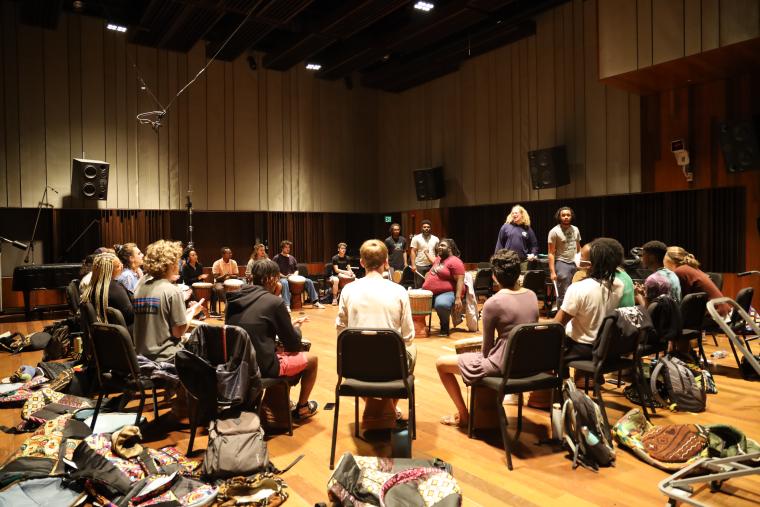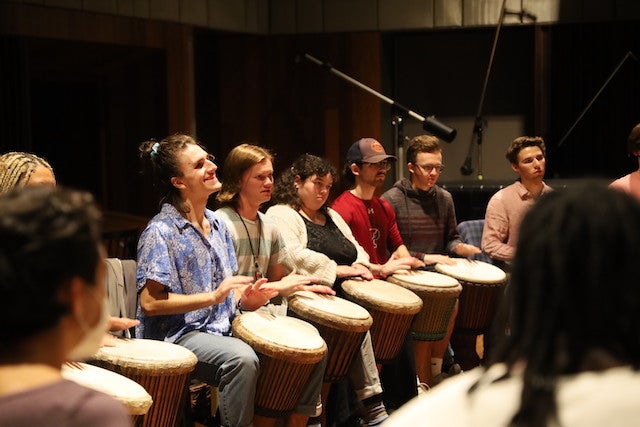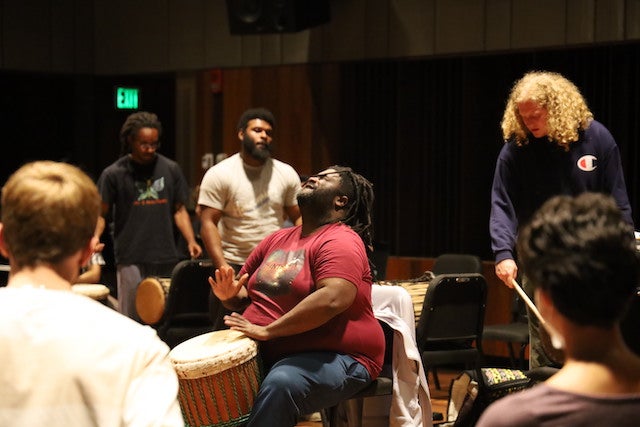A New Kind of Orchestra at Oberlin
This fall, Weedie Braimah started a new Djembe Orchestra, in which students learn the history and music of the Djembe from the 12th century to the present day.
November 18, 2022
Joshua Reinier

Photo credit: Joshua Reinier
An orchestra is about to perform. The hall falls quiet. What do you expect will happen next?
It’s probably not what Weedie Braimah, leader of Oberlin’s new Djembe Orchestra, has in mind. His orchestra is a circle of thirty or so students, each with a drum held between their knees, playing a dense polyrhythmic song and singing in call-and-response. At the center is Braimah, a legendary Djembefola (Djembe player), whose ambition is to teach his students a new way of understanding music.
Braimah began teaching at Oberlin to guide and lead students playing for the traditional West African dance class, led by professor Talise Campbell. His work with the Dance Department connects deeply to his other work at Oberlin. “If you can’t move yourself, how are you gonna move anyone else?” he asks. “You have to learn to speak this music.”
About his students, Braimah says, “They’re musicians and they’re training to be professionals—I can play this, I can read this—but the freedom of understanding how to move within that is the challenge. So my main goal is to strip all of that from them, and start at the beginning as if they were children. You have to understand that, first, you’re learning something that none of you know about. So you have to start from somewhere.”
 And since the beginning of the semester, they have come a long way. Kurton Harrison, a student in the class, says: “My experience in the Djembe Orchestra has been a blessing. Through practicing and listening to the different West African rhythms such as Kassa, Kassa Solo, Kassa Salia, and Soli, I have come to understand the true meaning of the Djembe.”
And since the beginning of the semester, they have come a long way. Kurton Harrison, a student in the class, says: “My experience in the Djembe Orchestra has been a blessing. Through practicing and listening to the different West African rhythms such as Kassa, Kassa Solo, Kassa Salia, and Soli, I have come to understand the true meaning of the Djembe.”
The Djembe has a long history dating back to the 1100s. Braimah explains, “Now, if I just put this drum inside of West Africa, everything in the interior of the drum will be considered Mandé territory during that time.” When the Mandé people started migrating to different areas, the music diversified and took on many different names, affected by the Ghana, Mali, Songhai, Ashanti, and other historical African empires. With migrations, techniques changed, and Braimah teaches how every part of the Djembe evolved from the 12th century to now. “That’s a lot of evolution to learn!”
Braimah has been integral in the recent evolution of the Djembe. Born in Ghana and coming from a long line of drummers playing jazz, traditional West African music, and other styles, Braimah grew up in St. Louis. When he found the Djembe in his early years, he immediately knew that was what he wanted to play. Throughout his expansive career working with artists including Chief Xian aTunde Adjua (formerly known as Christian Scott), Braimah has carved a path for the Djembefola, as opposed to the Western role of a percussionist (who often plays more than one instrument).
 Braimah clarifies, “Me, I’m not a percussionist. You see me with one instrument. Let’s break down the English vernacular. A percussionist plays a plethora of instruments. It’s an orchestral term, if we’re gonna talk about that. There’s no way that we can use a European vernacular to define African narratives. No one says this: On percussion, Thelonius Monk. On percussion, Max Roach. I’ve heard: On drums, Max Roach. We have to understand that this instrument has now evolved.”
Braimah clarifies, “Me, I’m not a percussionist. You see me with one instrument. Let’s break down the English vernacular. A percussionist plays a plethora of instruments. It’s an orchestral term, if we’re gonna talk about that. There’s no way that we can use a European vernacular to define African narratives. No one says this: On percussion, Thelonius Monk. On percussion, Max Roach. I’ve heard: On drums, Max Roach. We have to understand that this instrument has now evolved.”
The Djembe Orchestra is already a popular class. In addition, Braimah and Campbell are sponsoring a Winter Term trip to Gambia and Senegal, where students will get an opportunity to experience the musical and cultural traditions explored in his class. They have previously taken students to Ghana and Mali as well.
Braimah is excited about expanding the offerings of the Conservatory. “Because it's important. And our goal is for this tradition to stay and to live on in this college. Mm hmm. And that's that.”
You may also like…
Josh Nolan Named Vice President, General Counsel, and Secretary at Oberlin
Distinguished attorney brings extensive experience in higher education law.
Learning by Teaching: Oberlin Students Share Global Music with Young Learners
College and Conservatory students in PACE 103 prepare local children for an immersive community concert at Oberlin.
Nuiko Wadden ’02 Joins Oberlin Conservatory Faculty as Assistant Professor of Harp
The versatile musician brings extensive opera, orchestral, and contemporary music experience to her role


